Fred Lowen was one of the 2546 enemy alien internees who left England aboard the HMT Dunera, arriving in Australia in September 1940. These chiefly German, Austrian and Czechoslovakian civilians, mostly refugees and resident in the UK, were declared enemy aliens at the outbreak of World War 2. Many were Jewish people who had arrived in England to escape fascism and anti-Semitism in their own countries.
All male enemy aliens, aged 16 and over, amounting to 73,000 people, were assessed by tribunals to determine their level of risk. The initial classification system – A,B,or C (being least risk, and able to continue life with minimal oversight) was revised after the retreat of the British army from Dunkirk in May 1940 and with the threat from Germany escalating. There were now many more internees to be housed. 1
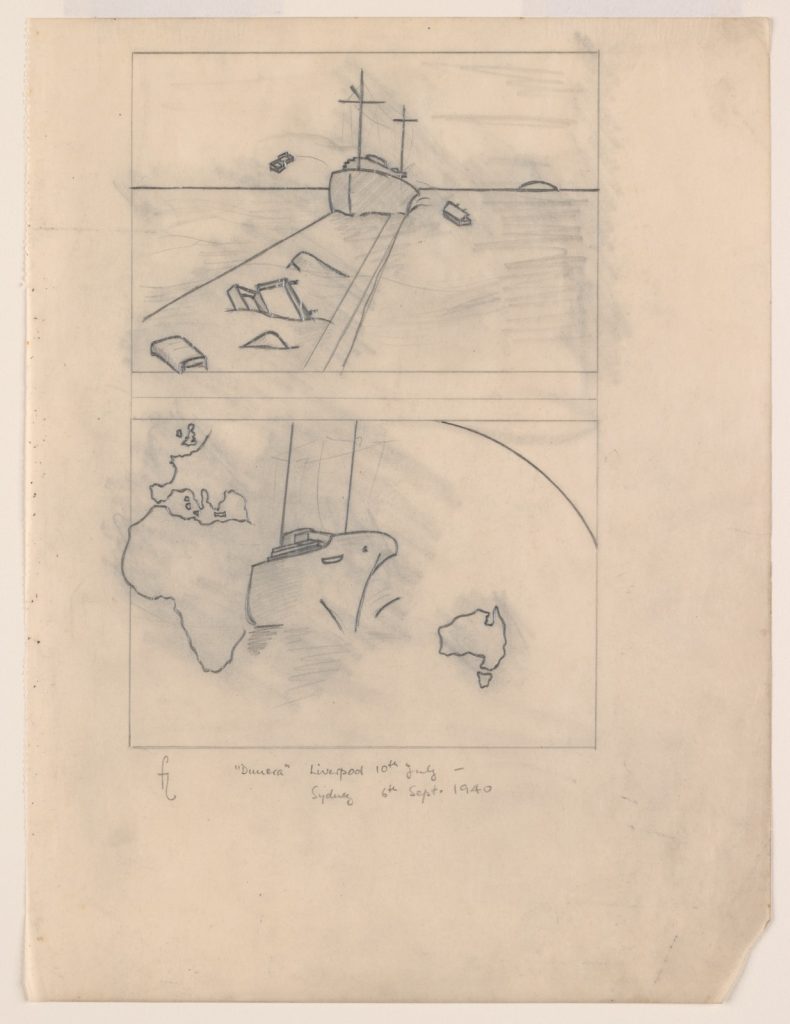
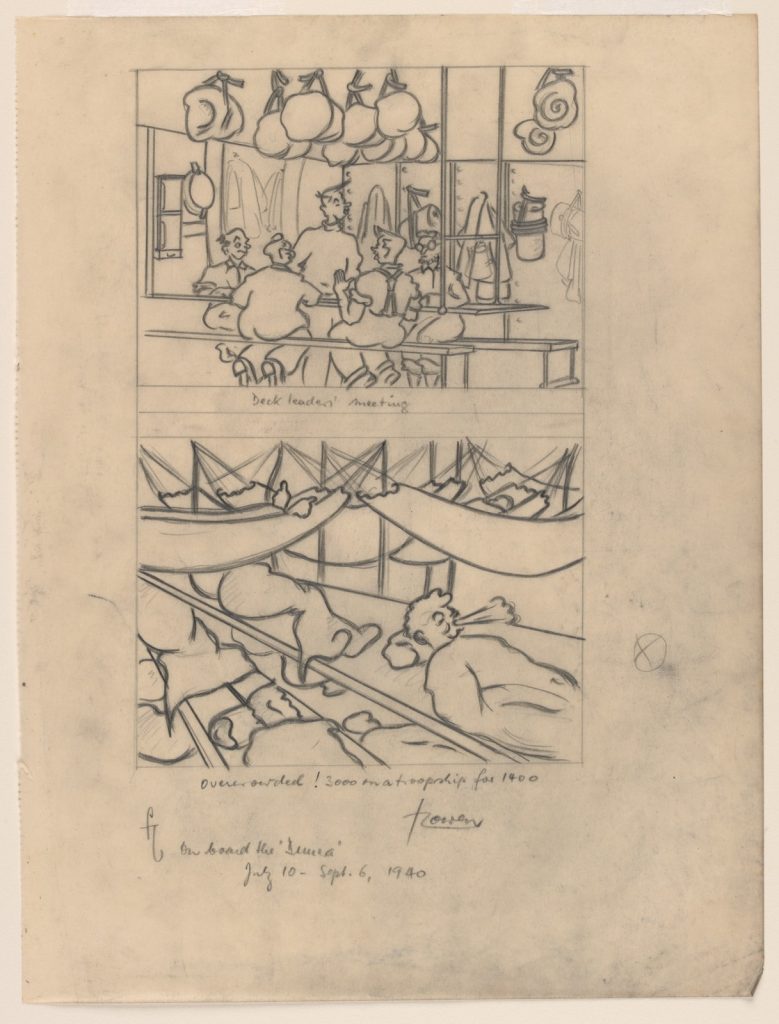
“Dunera”, Liverpool 10th July – Sydney 6th Sept.1940, drawing by Fred Lowen, H94.95/19
On board the ‘Dunera’ July 10th – Sept. 6, 1940, drawing by Fred Lowen, H94.95/20
These works are in copyright
To assist the British government, over 7000 people were transported to internment camps in Australia and Canada. Once in Australia, the new arrivals were sent to camps at Hay, Orange and Tatura. The passenger list included survivors of the SS Arandora Star, sunk on her voyage to Newfoundland, carrying Italian, Jewish and German internees and prisoners of war.
Charges of ill-treatment and theft of possessions during the Dunera’s voyage led to an official inquiry commencing in late 1940. Two of the Pioneer Corps were court martialled and the commander was severely reprimanded. Compensation was later paid to those whose possessions had been stolen.
In 1941, the British government, realizing that their earlier response was too harsh, reassessed the classification system. The “C Class” internees became eligible to apply for release. Major Julian Layton arrived in Australia in March 1941 – his mission “acting as liaison between the Australian Army controlling the camps, the British Home Office, and organisations in Britain and Australia dedicated to helping the internees.” 2
After the issue of the treatment aboard the Dunera had been addressed, Layton turned to working to free the internees from the camps, a proposal resisted by the Australian government. 3 In May 1941, the first 197 returned to England to join the Pioneer Corps. By the end of 1941 internees were being progressively released – with restrictions – in order to support the war effort. Others joined the Australian Army 4. By November 1943, only 90 Dunera internees remained at Tatura. 5 Ultimately, nearly 800 internees remained in Australia. 6 Fritz Lowenstein – Fred Lowen – was among those who decided to stay.
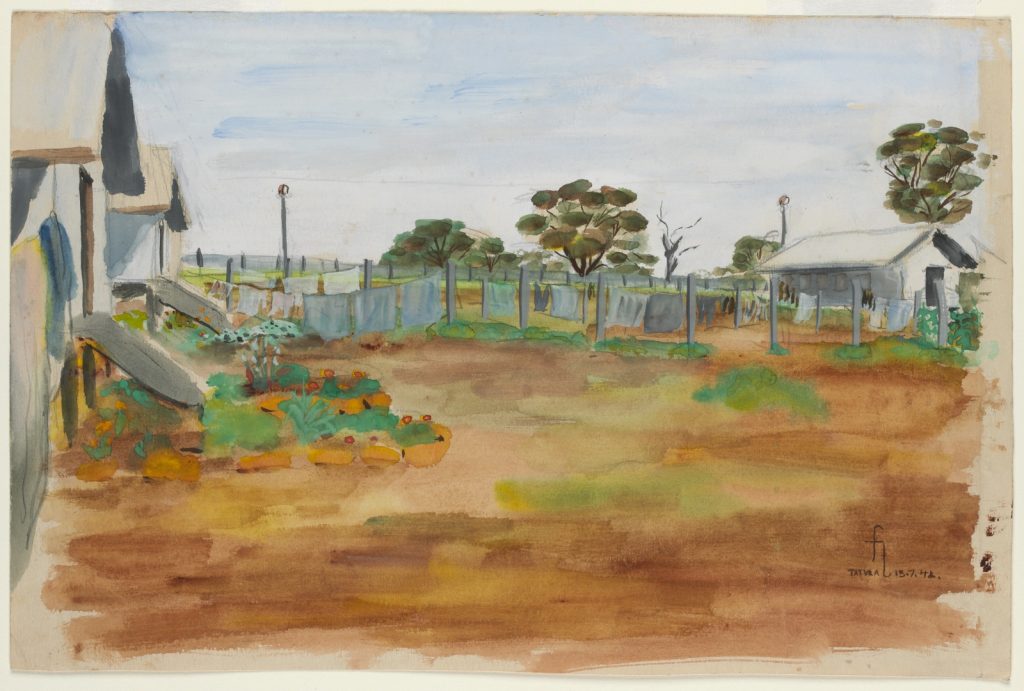
Fred Lowen was born in Upper Silesia in 1919 and moved with his family to Berlin in 1922. Germany was an increasingly unsafe place to be for a person with Jewish ancestry – and in December 1938 Lowen left for Belgium. He was able to get a Belgian identity card, as an illegal immigrant, and found work (illegally) with his Uncle Rudolf. 7
Soon, Belgium too became unsafe and Lowen with 150 others headed towards the French border. Finally, after dodging shells, bullets and bombs, they made it to Nieuwpoort, and then were towed out to sea on a fishing boat. Fortunately they were rescued by an English minesweeper, where they were warmly welcomed and fed:
Finally lulled by the humming engines, I fell asleep, Alfred woke me with a cup of hot cocoa, the sun was up and the sea quite calm. I put my dry clothes back on and was allowed to have a look outside: left and right there was an armada of destroyers, cruisers and hospital ships, and in the sky was an escort of British fighter planes. I could not believe we had actually escaped from that hell. About midday the English coast appeared on the horizon. I recognised the white cliffs of Dover and before long our ships entered the port. Much later I learnt that we had been right in the middle of the Dunkirk evacuation of the British army. 8
On arrival, Fred, along with the many other evacuees arriving in England from occupied Europe, was sent to Pentonville Prison. After moving several times, and missing a reunification with his mother by hours, Lowen boarded the Dunera on 10 July 1940. Arriving in September, after a grueling voyage – the conditions defying description 9 – the internees were transported west to the Hay Internment Camp.
Lowen was mindful of his response to these new circumstances:
…my escape from Belgium was still so deeply engraved in my mind that I kept thinking how incredibly lucky I had been and how I was looking forward to a new life in a strange but fascinating country on the other side of the globe. All this blunted my own experiences on the Dunera, but had a much deeper and more lasting effect on mots of the prisoners who had live in England before their internment.
10
Along with the Dunera boys, German, Italian and Japanese civilian Internees and Prisoners of War were sent to Australian internment camps. In June 1941, Lowen, recovering from a knee injury, was sent to Orange to recuperate – and then to Tatura, where he would spend the rest of his time in internment. 11
Lowen commented on the friendliness of the army guards, – ‘our Australian guards, mostly middle-aged soldiers, showed sympathy and compassion….we were each given delicious sandwiches and fresh fruit…we hadn’t seen anything like this for weeks! 12
We are very fortunate to have a collection of his works, drawn during his time of internment, illustrating day to day life, displaying his sense of humour as well as the isolation – and the landscape beyond.
In contrast to their experiences on the Dunera, this image captures a relaxed moment on the journey.
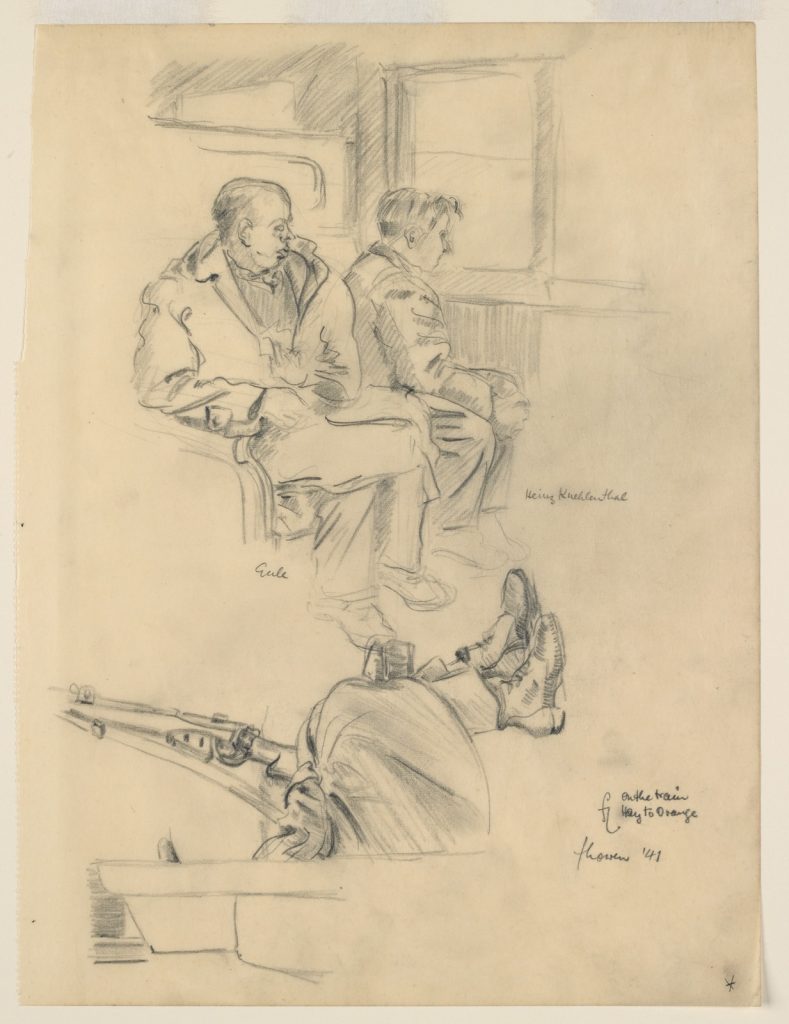
This work is in copyright; H94.190/7
Barbed wire was a motif used by many of the Dunera artists – shown below in works by Kurt Winkler and Herman Valentin, and Lowen.


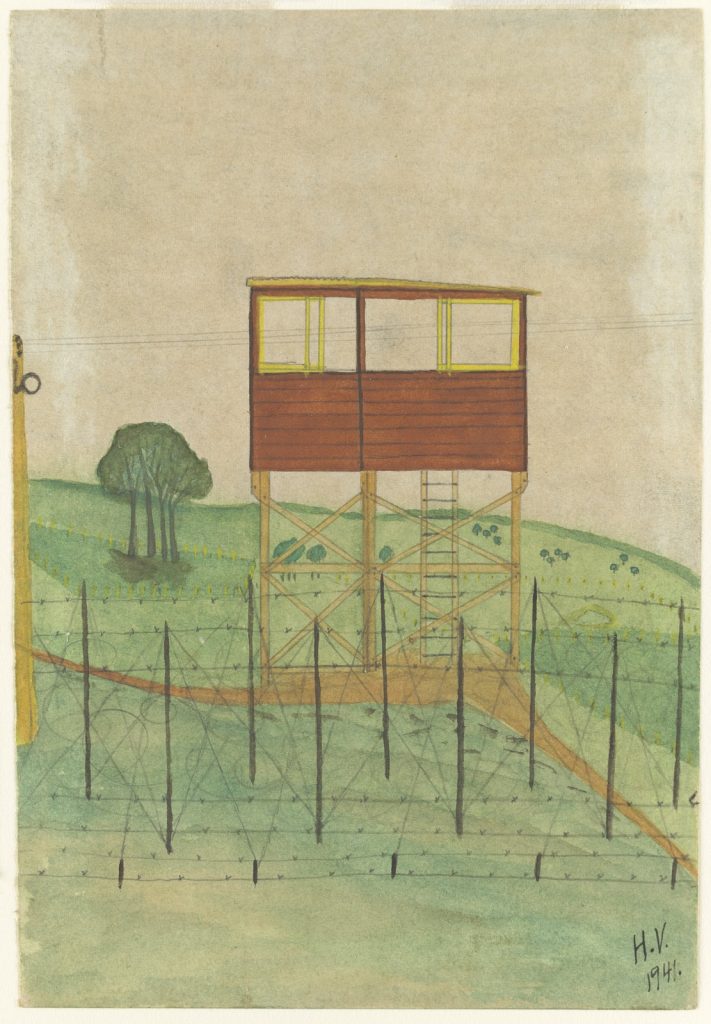
This work is in copyright; H85.89/2
Orange through barbed wire, drawing by Fred Lowen, 23 June 1941.
This work is in copyright; H91.350/7;
Watch tower and barbed wire fence at Tatura,
drawing by Hermann Valentin, 1941. This work is in copyright; H94.95/41
Lowen writes:
Life in the camp was a miniature model democracy. Each hut elected a hut captain, who in turn elected the camp leader, who was our spokesman with the military and other outside organisations. We had brilliant people in camp from all spheres of the sciences and arts. We had lectures in languages, physics, mathematics, literature, drawing and painting and many more subjects. There were talented musicians who gave memorable concerts, and plays were performed in the mess huts. Sports were also organised – handball, soccer, fistball and so on. 13
Lowen’s drawing and drafting skills are well displayed in the marvelous collection of drawings. Fortunately, relatives in Sydney sent him drawing materials which were rapidly put to use, documenting something of the lives of internees.

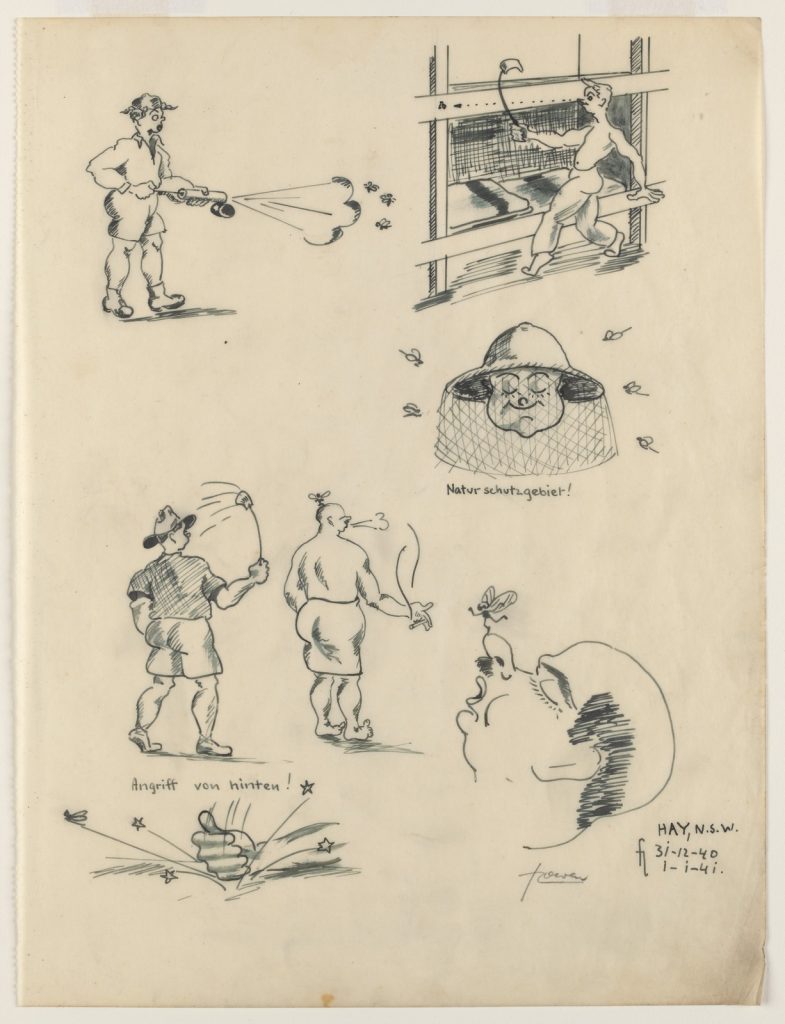
Hay, NSW, drawing by Fred Lowen, 31 December 1940, H94.95/12
These works are in copyright.
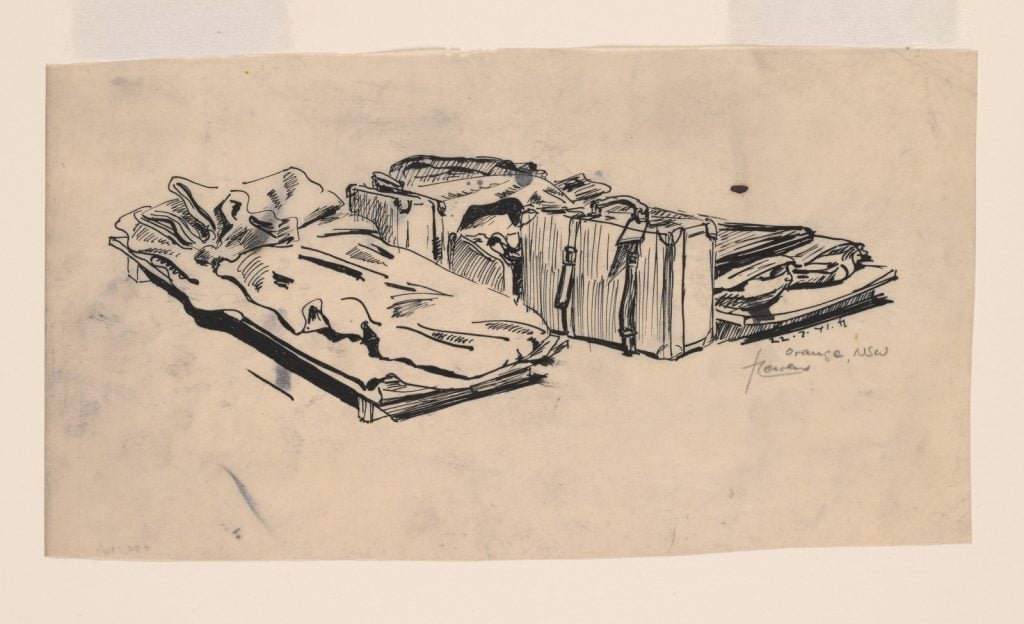
This work is in copyright; H94.190/1

This work is in copyright; H91.350/9

Lowen’s brush deftly captures these moments in time.
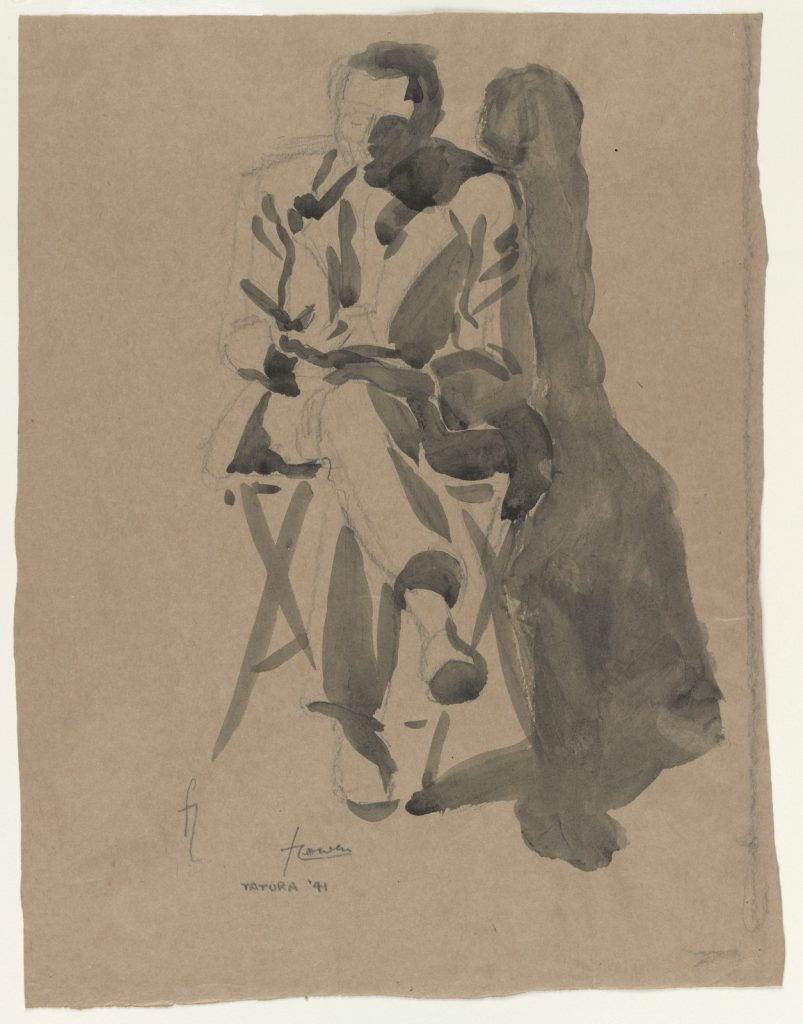

Figure Study: internee dressed in army fatigues, painting by Fred Lowen, 1941, H94.95/7
These works are in copyright
Lowen wrote in his autobiography of the sturdy boots, part of the regulation army issue attire. 14

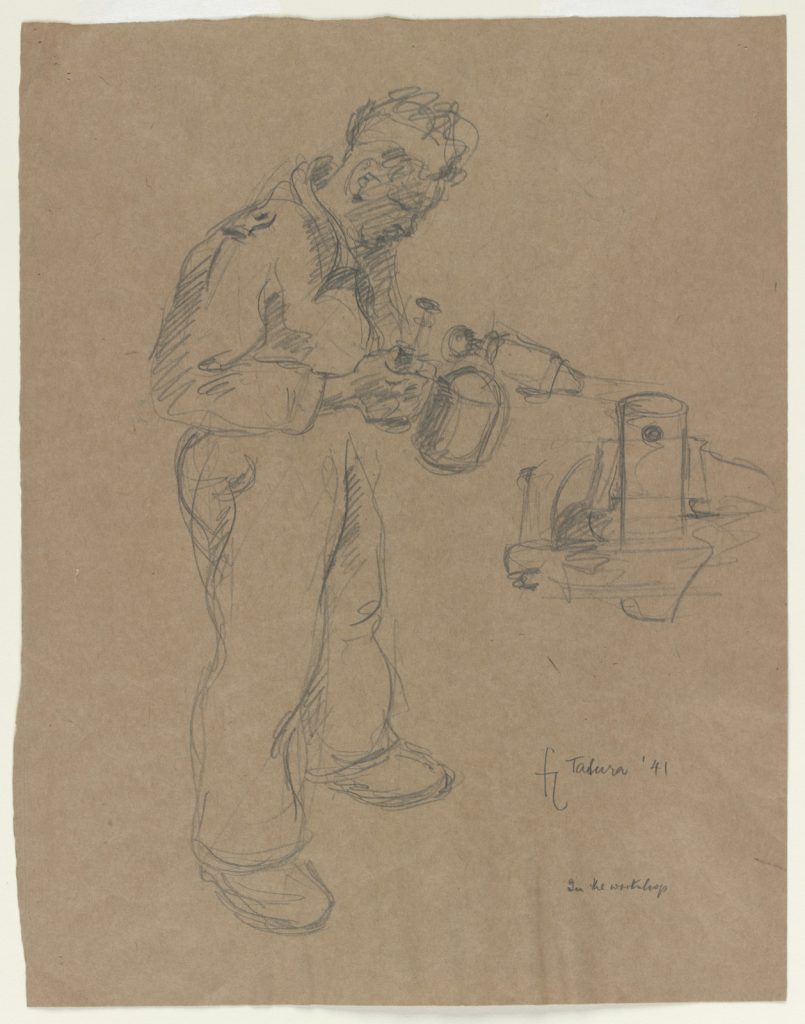
This work is in copyright. H94.95/6.
Lowen re-met Ernst Rodeck at Tatura and they worked together in the camp’s metal workshop. His newly developed skills enabled him to get a job as a metal worker in Melbourne
Major Layton wrote to Lowen in June 1942, asking if he would be prepared to stay in Australia, if a position could be found for him. Lowen responded enthusiastically, ‘yes!’15 Finally released for war work on 14 August 1942, Lowen boarded the train at Murchison, heading for Melbourne. He recalls his impressions on arrival:
The city looked beautiful, prosperous and peaceful. I was overwhelmed to see so many tall buildings, such as the Manchester Unity building in Swanston Street. I was particularly struck by the beauty of the public gardens. Here was a world that was still intact, and I was fortunate to be able to experience it and breathe the fresh air of a free country! 16
Lowen and Rodeck went on to form Fler, soon expanding into furniture design. The firm, and its later incarnation, Tessa, contributing significantly to the furnishing of Australian households – their designs, being rediscovered as mid-century modern, have become re-loved and reinvented.
Lowen’s design philosophy “was to create soundly crafted products. By searching for new materials and applying new technologies as well as adhering to the Bauhaus principles of Form follows Function I was able to create furniture which was visually pleasing, would adequately fulfill it’s function, and give lasting pleasure and satisfaction to its user…and be affordable to a broader target market.” 17
The Dunera Association, was formed to honour and remember their boys, and the Dunera news is “a publication for former refugees from Nazi and Fascist persecution (mistakenly shipped to and interned in Australia at Hay and Tatura, many later serving with the Allied Forces), their relatives and their friends.”
Further reading
Bartrop, Paul, R.,editor, with Gabrielle Eisen, 1990, The Dunera affair : a documentary resource book, South Yarra, Co-published by Schwartz & Wilkinson [and] The Jewish Museum of Australia
Dunera Association, accessed 9 August 2023 <https://www.duneraassociation.com/>
Heritage Council of Victoria, 2017, Tatura World War II Internment and POW Camps Collection, viewed 9 August 2023, <https://heritagecouncil.vic.gov.au/wp-content/uploads/2014/10/Tatura-WW2-POW-Internment-and-Camps-Collection.pdf>
Houlden, Jacquie, and Spark, Seumas, eds., 2022, Shadowline : the Dunera diaries of Uwe Radok, Clayton, Vic., Monash University Publishing
Inglis, Ken, Gammage, Bill, Spark, Seumas and Bunyan, Carole, 2018, Dunera lives, Volume 1 : a visual history, Clayton, Monash University Publishing
Inglis, Ken, Gammage, Bill, Spark, Seumas and Winter, Jay, 2020, Dunera lives, Volume 2, Profiles, Clayton, Monash University Publishing
Internment and beyond: stories from the Dunera and the Queen Mary, Monash University, accessed 9 August 2023, <https://dunerastories.sl.nsw.gov.au/>
Lowen, Fred, Fred Lowen : Dunera boy, furniture designer, artist, [2000], Castlemaine, Prendergast Publishings
National Archives of Australia, Wartime internment camps in Australia, viewed 8 August 2023, <https://www.naa.gov.au/explore-collection/immigration-and-citizenship/wartime-internment-camps-australia>
National Museum of Australia, Defining moments – Dunera boys, viewed 9 August 2023, <https://www.nma.gov.au/defining-moments/resources/dunera-boys>
References
- Inglis, Ken, Gammage, Bill, Spark, Seumas and Bunyan, Carole, Dunera lives. Volume 1 : a visual history, Clayton, Monash University Publishing, 2018, p 42-3
- as above p 34
- as above p 31
- as above p 40
- as above p 43
- The Dunera experience : an exhibition at the Jewish Museum of Australia, 1990, South Yarra, The Museum, p 23
- Lowen, Fred, Fred Lowen : Dunera boy, furniture designer, artist, Castlemaine, Prendergast Publishings, [2000], p 17
- as above p 40
- as above p 56
- as above p 57
- as above p 57
- as above p 57
- as above p 60
- as above p 60
- as above p 77
- as above p 78
- as above p 232


no pictures of the furniture written about?
were there socks to go with the sturdy boots?
soap? et al
my Australian family originated in Silesia, where I have visited.
there was negative feeling for Germans after Hitler’s performance-
the area I grew up in was all German Lutheran Farmers.
when my Brit Dad returned on a brief leave after serving in the Australian army in Palestine and Lebanon he was joyously welcomed. After he went back my sister Pamela was born…
Hello Kay – thank you for reading the post – generally, we just included material we hold in our blog posts – and we don’t have any photographs of Fred Lowen’s furniture. Here is a link to a site with some images of the furniture made under the Fler label, and Tessa, a later label.
https://www.carters.com.au/index.cfm/index/1222-lowen-fred-australia-mid-century-furniture-designers-and-makers/
Thank you for sharing some of your family story too.
I was lucky enough in my life to meet and in most cases to have ongoing contact with seven of the Dunera boys. They contributed greatly to their new country. I am glad to see that their unjustified ill -treatment as internees ceased in due course, and that their stories are still being worked on and published.
Hello Barry – thank you for reading the post – there are many remarkable stories, and wonderful too, the work that has been done to record and honour their achievements and contributions.
Enjoyed reading your blog on Fred Lowen, having his voice along with his pictures gave a real insight to his life experiences.
Hello Geraldine – thank you! It was good to be able to combine those elements in the post. Lowen’s autobiography is well worth reading and includes more of his artworks as well.
Thank you for this wonderful survey! Might I mention, in passing, that Max Vorcheimer, a long-term and much respected State Library colleague who retired a few weeks back, is the son of a Dunera boy, Moritz Vorcheimer?
Thank you Walter, in writing this it was good to discover more of the Dunera story and the experiences of internees, thank you for the information about Max’s father too – yes Max was a much respected colleague.